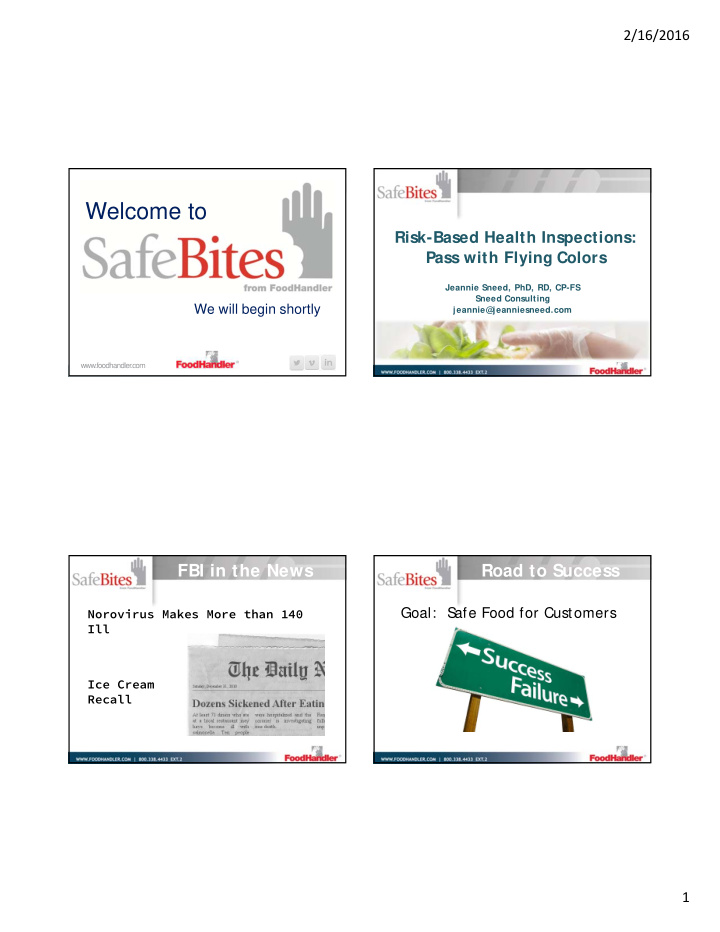



2/16/2016 Welcome to Risk-Based Health Inspections: Pass with Flying Colors Jeannie Sneed, PhD, RD, CP-FS Sneed Consulting We will begin shortly jeannie@ jeanniesneed.com www.foodhandler.com FBI in the News Road to Success Norovirus Makes More than 140 Goal: S afe Food for Customers Ill Ice Cream Recall 1
2/16/2016 Inspections Goals for Today An inspection provides a snapshot • Identify foodborne illness risk factors • Describe risk ‐ based inspection methods • Apply active managerial control to reduce risk factors and protect consumer health 2013 FDA Food Code Top 5 Pathogens Causing FBI • Norovirus ‐‐ 58% Annex 5—Conducting Risk ‐ Based Inspections • Salmonella (non ‐ Typhi) ‐‐ 11% • Clostridium perfringens ‐ ‐ 10% • Campylobacter spp. ‐‐ 9% • Staphylococcus aureus ‐‐ 3% (CDC, 2011) 2
2/16/2016 FBI Risk Factors Control Measures • Food from unsafe sources • Demonstration of knowledge • Inadequate cooking • Implementation of employee health policies • Improper holding temperatures • Hands as a vehicle of contamination • Contaminated equipment • Time/temperature relationships • Poor personal hygiene • Consumer advisory Risk-Based Inspections Good Retail Practices Majority of time focused on: GRPs are assessed during a risk ‐ based inspection, but they tend to: 1. Compliance with food code provisions related to FBI risk factors • Be static, whereas risk factors tend to be more dynamic 2. Degree of active managerial control operator has over risk factors • Present less of a public health risk than risk factor violations 3
2/16/2016 Good Retail Practices Risk-Based Inspection Methods Examples: A. Focus inspection • Facility and equipment maintenance and B. Lead by example storage C. Conduct at variable times • General cleanliness of premises D. Establish priorities and use time wisely • Water, plumbing • Storage of dry goods Questions to Ask Do a Quick Walk-Through During the quick walk-through or before, • Meant to be QUICK – 2-3 minute in questions will be asked to determine how duration the following are being conducted: • Purpose: Determine the critical – Cooking/Preparation processes being conducted at the time of the inspection – Cooling • Normally, issues would be – Reheating addressed later – Receiving 4
2/16/2016 Reviewing the Menu Establish Priorities Conduct a menu/food list review Helps identify: • High ‐ risk foods or high ‐ risk processes • Operational steps that often go unevaluated 18 18 2013 Food Code TCS Foods (p. 22) • Includes: • Definition: – Animal food (raw or heat ‐ treated) • Time/temperature control for safety food – Heat ‐ treated plant food (formerly “potentially hazardous food (PHF) – Garlic ‐ in ‐ oil mixtures that have not been modified means… to prevent growth – A food that requires time/temperature control for – Raw seed sprouts safety (TCS) to limit pathogenic microorganism – Cut melons growth or toxin formation. – Cut tomatoes or cut tomato mixtures – Cut leafy greens 5
2/16/2016 Risk-Based Inspection Methods, Food Preparation Processes cont. E. Determine process flows • Process 1: Food Preparation with No Cook Step F. Determine foodborne illness risk factors in process flows • Process 2: Preparation for Same Day Service • Process 3: Complex Food Preparation Process 1: No Cook S tep Receive Store Prepare Hold Serve Examples: Tuna Salad, Sushi, Cold Cut Sandwiches 23 23 6
2/16/2016 Process 2: S ame Day Inspection Priorities for No Cook • Cold Holding or Time as a Public Receive Store Prepare Cook Hold Serve Health Control • Food Source Examples: Hamburgers, baked fish, fried • Receiving Temperatures shrimp, tacos • Freezing to Destroy Parasites (Fish for Sushi) • Cooling from Ambient Temp Inspection Priorities for S ame Day Process 3: Complex Receive Store Prepare Cook • Cooking Cool Reheat Hot Hold Serve • Hot Holding • Time as a Public Health Examples: Beef Stew, Soups, Gravy, Chili Control 28 28 7
2/16/2016 Inspection Priorities for all Processes Inspection Priorities for Complex • Employee Health Policy • Cooking • Personal Hygiene Program • Hot Holding (Handwashing/No Bare Hand • Time as a Public Health Contact) Control • Food source • Cooling/Cold Holding • Reheating 29 29 Inspection Priorities for all Processes Standard Operating Procedures • Cleaning and Sanitization of Food • Importance Contact Surfaces – Employee health and hygiene • Cross ‐ Contamination Related to – Time and temperature control Storage and Preparation – Sanitation • Date Marking RTE, TCS Foods • Sources • Calibration of Thermometers – www.theicn.org – http://www.extension.iastate.edu/foodsafety/HA CCP 31 31 8
2/16/2016 Prevention of Contamination FDA Guidance from Hands Prevention of fecal ‐ oral route transmission is key Risk-Based Inspection Methods, Active Managerial Control cont. An establishment may be IN COMPLIANCE at the G. Assess Active Managerial Control time of inspection but lack AMC Role of AMC: Strengthens the food safety management system May lead to better long ‐ term compliance Provides consistent, comprehensive control over the risk factors to reduce odds of foodborne illness outbreaks 36 36 9
2/16/2016 Elements of FS S ystem with AMC Assessing Active Managerial Control Assessing AMC: Elements of a food safety management system Involves more than just assessing code designed to achieve AMC: compliance Food Safety Procedures/Policies Helps inspector know what happens routinely Monitoring Procedures Requires asking open ‐ ended questions Corrective Action Procedures to supplement quantitative measurements or Management Oversight (Verification) observations Training Periodic Re ‐ evaluation of Procedures/Policies 37 37 38 38 Food Safety Management Simulated “Walk-Through” System • Certified Managers • SOPs • Recipe cards with critical limits • Purchase specifications • Trained managers and employees • Monitoring/Recordkeeping • HACCP or risk control plans • Appropriate facilities and equipment 10
2/16/2016 11
2/16/2016 12
2/16/2016 Operational Ups & Downs Questions? Jeannie Sneed, PhD, RD, CP ‐ FS jeannie@jeanniesneed.com 13
Recommend
More recommend